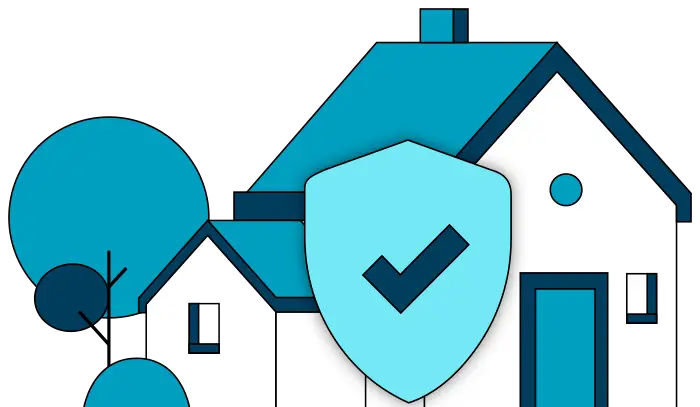Your attic is an integral part of your home. Not only does it provide storage for you and your family, but it also helps control the temperature in your home. So, when your attic becomes damaged, it is important to fix it immediately. When dealing with this type of damage, it may lead you to ask, does home insurance cover attic damage?
Your homeowners insurance will cover attic damage in specific scenarios. For example, if your home has a roof leak and it damages the attic, your insurance will likely cover this peril if it is sudden and unexpected. On the other hand, if your attic is damaged by pests or mold, the insurance company will likely deny the claim.

If you want to know more about what attic damage is and isn’t covered, continue reading to get the ins and outs below.
- Your attic is covered under your dwelling coverage A.
- Pest and mold damage is often not covered by standard homeowners insurance policies.
- Other exclusions may occur when it comes to your attic, these exclusions are listed in the homeowners insurance policy.
When is the attic damage covered
Attic damage can cause a lot of stress to a homeowner. This is because the attic is an integral structural component of a home. It plays a large part in insulating your home from hot and cold temperatures outside and might be used for storage. When your attic is damaged, it is important to get it repaired immediately. You may think to call your insurance agency to file a claim, but before doing so, it is important to understand what is covered.
Your attic is covered under your dwelling coverage on your homeowner’s insurance policy. This coverage often provides policyholders with coverage for damage to the dwelling structure, including the attic, that is the result of a covered peril.
There are 16 named perils that most homeowners policies cover. These 16 named perils are:
- Fire and lightning
- Smoke
- Windstorms and hail
- Explosions
- Vandalism
- Damage from a vehicle that you don’t own
- Damage from an aircraft that you don’t own
- Theft
- Falling objects (like fallen trees)
- Weight of ice, snow, or sleet
- Accidental discharge or overflow of water
- Riots or civil unrest
- Freezing of household systems
- Pipe freezing
- Volcanic eruption
- Power surges
If the damage caused to your attic is the direct result of one of these named perils, your insurance policy will cover the cost to repair or replace your attic, less the deductible. Since the attic will be considered under the dwelling structure coverage A part of the policy, it will be subject to the dwelling structure coverage maximum limit.
It is important to note that if you have a popular HO-3 or premium HO-5 policy, your attic will be covered on an open-peril basis. This means that even more perils are covered by these policies than the 16 listed above. These plans will cover your attic from all damage except for the excluded causes listed in the policy.

When attic damage is not covered
There are instances when your insurance provider may deny a claim. It is important to be aware of the instances that could disqualify your attic from coverage. Below are some key examples of instances that insurance likely will not cover.
Acts of war
One circumstance that may result in the denial of a claim is an act of war. If your attic is damaged due to an act of war (think heavy artillery), then your insurance company will not cover the cost of repairing or replacing the attic. This is because, in many cases, acts of war are considered to be exclusions in homeowners policies.
Nuclear incidents
If you live near a nuclear power plant, and it has a sudden explosion that results in damage to your attic, or other parts of your property or dwelling, your insurance claim will likely be denied. This is because nuclear incidents are also considered exclusions in most insurance policies. Homeowners need to purchase add-on insurance or a separate policy to cover this type of event.
Mold
If your attic is full of insulation that has gotten moldy and damaged, it can cause rot and other damage to the surrounding structure. This can stem from leaks, holes, and other roof damage. Mold is not typically covered under a homeowners insurance policy. This is especially true if the mold is the result of normal wear and tear or homeowner neglect.
Frequently asked questions
Does home insurance usually cover rodent damage in the attic?
When it comes to pests and the trouble they cause in our homes, insurance companies are very picky about what they will and will not cover. For example, if a rodent infestation occurs in your attic and it destroys the insulation, wood, and roof, you may be looking at a large bill. This bill will likely become an out-of-pocket expense. Homeowner’s insurance views pest control as normal maintenance and places the burden on the homeowner to handle the situation before it becomes a larger problem. Neglecting the issue can cause severe damage, and insurance companies will not cover such neglect.
Does home insurance cover guano in the attic?
When it comes to guano, which is a term for bat and seabird excrements, insurance agencies are particular about what they will or will not cover if your attic is damaged. For instance, homeowners insurance will not cover bat removal. This is considered a maintenance cost, as bats often sneak into your home through pre-existing gaps and holes. However, if the bat causes structural damage to the attic, the policy may cover the damages and repair if bats are not specifically listed as an exclusion.
Does homeowners insurance cover mold in the attic?
Mold can be a beast to remove from any home. It can sneak into tiny cracks and crevices and get in behind your walls and infest your insulation. This can become costly and make you look to your home insurance policy to mitigate costs. Homeowners insurance will cover mold that is caused by one of the covered perils under the insurance policy. Homeowner insurance will not cover mold from flooding, acts of nature, or neglect. The line between a mold that is and that is not covered is fine. It is always a good idea to check with your insurance agent to confirm coverage.
Your attic is secure
In most instances, your attic will be covered if it faces damage or loss. Regularly check in with your insurance provider to ensure you have the proper coverage to meet the needs of your home and family.

